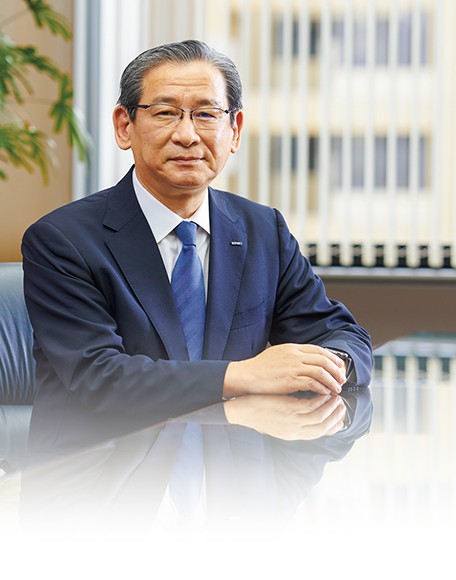- Value Creation Story (PDF)
- CEO
Commitment - Growth
Strategies - Financial Strategy
- Latest
Creative Report - Corporate Oversight

Striving to build a stable financial foundation in order to achieve flexible growth assets geared toward an evolving market.
Kenkichi Nomura
Director, Executive Corporate Officer
and Chief Financial Officer (CFO)
- Please explain your role.
- I support business activities from a finance perspective, aiming to achieve asset optimization based on our management strategy.
In addition to my responsibilities as CFO, which involve planning financial strategy and seeing it through to execution, I am also the Executive Corporate Officer who oversees the whole of corporate management. As our business structure undergoes major changes, I have also been placed in charge of planning and strategy for the company since April 2020. I am involved with building our digital enhancement stategy along with our other various programs underpinning the growth strategy the CEO and COO were pivotal in formulating, so that we can achieve flexible and efficient investment, augment our business performance, and improve our asset efficiency.
As CFO, I strive to build a strong and flexible financial foundation based on our traditional financial strategy of securing a stable cash flow and improve asset efficiency. In my new role overseeing management, planning, and marketing strategy, we are working on more closely linking management and business.
- Have there been any modifications to the financial strategy with the changes to the business environment brought on by the COVID-19 pandemic?
- There have been no modifications. We will continue supporting growth assets with a financial foundation prioritizing cash flow.
In an effort to bring our growth strategy to fruition, Capcom invests 30 billion yen in development annually, primarily in our Digital Contents business. In order to steadily invest 36.5% of projected sales in research and development, we need to build a strong and flexible financial foundation. We are promoting Capcom’s growth strategy and working to grow our business performance with high capital efficiency by achieving proactive development investments based on improving our net cash.
In the fiscal year ended March 2020, investing in our growth led to achieving the highest sales volume on record in the Consumer sub-segment. Net cash increased by 14.2 billion yen, and the operating cash flow on sales ratio reached 27.3%, setting a new record high for profit. We were fortunate that our digitalization of game sales helped us avoid any major impact from the novel coronavirus pandemic. In addition, the balance of cash and deposits is equal to approximately 2.2 years’ worth of annual development investment, so there is no concern financially. However, witnessing the impact it has had on other businesses, I am once again reminded of the weight cash carries and the importance of building a financial foundation that matches the characteristics of our business.
During this seven-year period where net income has increased consecutively each year, Capcom’s earnings structure has undergone significant changes due to the digitalization of our sales channels and extension of our earnings period. However, we were able to support growth investment appropriately with the financial foundation we have built thus far. Looking at the market over the next 10 years, we can expect major changes on a scale unlike any we have seen before with the emergence of new technologies, hardware, and services. Our investment options will likely expand even further, which means we must be ready from a financial perspective.
As CFO, I will continue my efforts to select and concentrate investments while continuously reviewing costs, such as SG&A expenses, in order to build an even tougher financial foundation. In addition, I aim to use our accumulated cash to bring our growth strategy to fruition and further improve asset efficiency through flexible, optimized allocation of investments in strategic projects, such as major title development, investments in strengthening digital, adapting to new technologies and services, and our endeavors in esports and the mobile business.
- What are the priority financial KPIs and measures to improve them?
- We are prioritizing increasing operating income by 10% each fiscal year in addition to capital efficiency (ROE).
As one of our medium-term management goals geared toward investors, we are targeting an annual increase of 10% in operating income, which represents the profit we earn from our main business. At the same time, we aim to improve our operating margin, which is an indicator of our business efficiency, our net income, which represents our final profits for the fiscal year, and free cash flow, which is the source of returns to shareholders and further growth.
In the rapidly changing game industry, in order to manage with a well-honed foresight, we check changes such as the aforementioned indices and compare to the matrix of sales, year-over-year, and planned to actual ratios, and then take swift action in response to issues. As a result, the operating income growth rate over the last five years has been +116%, giving the operating margin an improvement of +11.5 percentage points and positioning Capcom at the top of the industry when compared to our competitors. Also, during this period, the net profit growth rate was +141% and free cash flow improved significantly.
Rate of improvement of operating income/
operating margin (compared to FY ended March 2015)
| Operating Income | Operating Margins | |
|---|---|---|
| Capcom | +116% | +11.5 points |
| Konami Holdings | +114% | +5.2 points |
| Square Enix Holdings | +99% | +2.8 points |
| Sega Sammy Holdings | +57% | +2.5 points |
| Bandai Namco Holdings | +40% | +0.9 points |
Note: Comparison of fiscal years ended March 2015 and 2020
Source: Created by Capcom based on financial reports and financial announcement materials
Additionally, ROE (return on equity), which we emphasize as an indicator of capital efficiency, was 16.9% this fiscal year. This number has been rising steadily alongside the growth of our business for seven consecutive years, creating value for shareholders.
ROE
| ROE | |
|---|---|
| Capcom | 16.9% |
| Konami Holdings | 7.3% |
| Square Enix Holdings | 10.0% |
| Sega Sammy Holdings | 4.6% |
| Bandai Namco Holdings | 13.1% |
| TSE 1st Section Average | 6.6% |
Note: Performance for the fiscal year ending March 2020
Source: Financial reports, Japan Exchange Group (JPX) homepage
The digital strategy we have been promoting since 2013 is the foundation behind this growth. By enhancing our income from not only our new major titles but also sales of our catalog title assets, we can grow our income efficiently without relying on expanding our capital. We are currently focusing on ROA (return on assets), in addition to ROE, and have improved 12.0% this fiscal year. We will continue to promote our digital strategy in the coming fiscal year as we aim for improvement in all our KPIs. We expect our operating income to increase 11.7% to 25.5 billion yen, our net income to increase 12.9% to 18.0 billion yen, and our operating margin to improve 2.0 percentage points increasing to 30.0%. ROE is projected to be 16.9%, which is on par with the previous year. In order to achieve these plans, I will conduct thorough checks of the aforementioned items as a company executive and focus on efficiency in my management of the balance sheet.
| 3/2018 | 3/2019 | 3/2020 | 3/2021(plan) | |
|---|---|---|---|---|
| ROE (%) | 13.4 | 14.4 | 16.9 | 16.9 |
| Net margin (%) | 11.6 | 12.5 | 19.5 | 21.2 |
| ROA (%) | 8.9 | 10.1 | 12.0 | – |
| Financial leverage (times) | 1.46 | 1.39 | 1.44 | – |
- Specifically, what kind of growth strategy investments do you make?
- We invest 80% of management resources in the core Digital Contents business.
To achieve stable medium- to long-term growth, we recognize that it is critical to secure a sufficient amount of investment for the Digital Contents business, the source for our original IP. Specifically, in addition to an enhanced title lineup and new technologies, we must invest in hiring more developers and improving our development environment. In the fiscal year ending March 31, 2021 we will allocate 29.0 billion yen, or 80% of total investments (R&D investment and capital investment amounts totaling 36.4 billion yen), in the Digital Contents business. As an index for measuring our investment level adequacy, we strive to appropriately manage the amount of our annual development investment and our work in progress for game software balance. Regarding the work in progress for game software balance recorded on the balance sheet, while it takes two to three years or more to develop a game, digital distribution has extended the content sales period, therefore we are striving to maintain the soundness of our assets with appropriate checks on the development of in-progress content.
Capcom employs two methods of properly managing development investments to increase title income, and efficiently generating net cash. The first is thoroughly managing investment recovery by creating a return on investment (ROI) database for each title and managing the process of investment income. If progress is going well on titles in development, we continue with the initial projected investment, but if there is an issue, we attempt to make improvements at an early stage and then reevaluate the potential of continuing investing. The second is the thorough improvement of working capital efficiency by checking in-progress assets continuously and working to create a mechanism to further visualize the number of turnover days and turnover rate.
As a result of these efforts, the net cash at the end of the fiscal year rose by 14.2 billion yen to 58.9 billion yen. In addition, when you consider the temporarily rising and falling accounts receivable and the balance of obligations at the end of the fiscal year that accompanied the major titles released before and after the holiday season in the latter half of the fiscal year, effective net cash increased to 69.0 billion yen.
We expect the amount of investment to gradually increase with the steady hiring of new graduates to expand our pipeline and to address new hardware and technologies. We will continue to carry out investment allocation and processes management in a manner appropriate for achieving growth investments.
- What is the status of cash and fund procurement?
- We have secured levels enabling us to respond to the increasing scale of game development and longer sales periods.
The increasing sophistication and functionality of game platforms brings rising development costs for consumer game software. In addition to the fact that it can take two to three years, or more, to develop a major title, the realization of extended sales periods with the penetration of digital sales has resulted in longer specified periods for recovering investment capital. (When package sales were mainstream, demand was concentrated in the first one to three months after a title was released, and development costs were recovered within that period.)
Under these circumstances we have set the level of cash and deposits we should hold in reserve as the amount of one to two years of annual development investment costs in consideration of the reserves for planned title development investment and risk management. However, when we consider the further development of content in this industry over the next 10 years as well as the possibility of a major transformation of our business structure, we can see the need to create a system that increases our cash position by an additional year to enable more flexible investment. At the end of the current fiscal year our cash and deposits balance was 65.6 billion yen due in part to the growth in our performance, but we will continue to strive to strengthen our financial foundation even further.
- In terms of shareholder returns, what is the position of treasury stock?
- From the perspective of total returns ratio, we are making flexible acquisition a pilliar on par with dividends.
At Capcom, we consider the acquisition of treasury stock an important policy for raising share value by increasing earnings per share. Accordingly, when we determine that it will contribute to improving shareholder value based on changes in the management environment and financial content, we have been flexiblly acquiring treasury stock (most recently in 2017 and 2019).
The average of the total return ratio for the last 10 years combined with dividends has been 58%, and we will continue to implement the optimal course of action as the opportunity arises.
Regarding the treasury stock we are currently holding, we are reviewing the appropriate measures for available options from the perspective of new technology, business growth, and improving capital efficiency.









